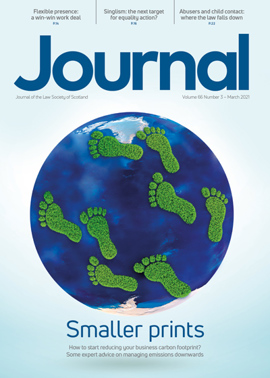Post-pandemic flexible working: not so remote

COVID-19 has shaken up our working patterns like never before, but employers needn’t fear the repercussions. It’s true that people want more flexibility. But the vast majority want relatively small adjustments, such as a bit more homeworking or slight changes to start and finish times. Very few want to reduce their hours.
Our research, a survey of 1,002 Scottish non-furloughed working adults carried out by Jump Research, shows that 61% of Scots worked from home at least some of the time during the first wave of the pandemic, and nearly a third (29%) flexed their hours too, as they juggled work with homeschool, childcare, and other personal responsibilities.
While the pandemic necessitated these changes, and they have often been far from ideal – flexible working does not usually materialise overnight, or come with simultaneous childcare duties – the experience has proved to employers and employees that it is possible to work in different places and at different times and still meet business objectives. In fact, more than three quarters (76%) of 204 Scottish business leaders and managers we surveyed credit flexible working with helping their business survive the first wave of the pandemic.
Business case
It’s well established that flexible working benefits business as much as the individual. Our research with business leaders shows 70% think flexible working improves staff loyalty, 67% say it increases productivity and engagement, and 66% say it reduces staff sickness and absenteeism. This backs existing findings that flexibility also helps companies recruit and maintain talent, reduce costs and improve employee mental health, wellbeing and work-life balance: CIPD factsheet on flexible working; ACAS research paper.
Increased demand
It’s true that people want more flexibility as a result of the pandemic. More than half (55%) of Scottish workers say they are considering requesting more flexibility, while 27% say they will definitely request it. But the type of flexibility they want is usually fairly small. Our research shows 45% would like more homeworking, 32% want flexitime (small amends to start/finish times), 21% would like compressed hours and 19% want occasional ad hoc changes. Only 13% want part-time hours and only 5% want a job share.
Some employers worry that embracing flexibility will result in large numbers working part-time with no one in the office. Our research shows this is a myth. Going part-time means reducing income, and not everyone wants to or can do this. Also, we know from feedback during the pandemic how much people have missed the office.
Hybrid future
Everyone’s talking about a blended approach to home and office working. And many organisations are thinking about working hours as well as location. Among employers we surveyed, 61% said they expected to offer staff more homeworking after the pandemic, while 45% expected to offer more ad hoc adjustments and 44% said more flexitime. Greater flexibility is clearly here to stay, so how do businesses move off a crisis footing, reacting to Government guidance, on to something strategic – and practical – that truly works for employees and employers?
We’ve put together the guidance on these pages to help. Or you can visit flexibilityworks.org for information on how we can support your organisation, and free resources on how to work remotely, or manage remote workers.
How to manage hybrid teams so everyone feels valued and motivated
- Find out what people want and canvass ideas – People often want only small amounts of flexibility, and come up with team solutions themselves.
- Be clear about who is available when and where – Use digital diaries and email signatures as reminders.
- Set up a team protocol – Involve the whole team in discussions about objectives/deliverables and how, when and where people are working and how to contact them. The team can agree how frequently everyone needs to meet face-to-face, formally and informally, and set core hours/slots for this. The protocol helps everyone feel included and informed, and can be reviewed regularly as circumstances change.
- Invest in training and support for line managers – They may feel nervous, and training will ensure they establish positive, two-way communications. The onus should be on both sides to check in/update.
- Model good behaviour from the top down – Ensure you have senior buy-in, and normalise flexible working by showcasing executive flexible work patterns.
- Good communication – whether it’s personal, or all-company, greater communication and honesty has helped firms weather the pandemic. Wellbeing is fast rising up corporate agendas and it all starts with being able to have a conversation.
How to ensure you deliver for clients
- Smooth team dynamic – Use the tips above to ensure teams working on external accounts know when colleagues are available and how to get hold of them quickly. Encourage colleagues to check in with each other and ensure the client knows who to contact.
- Only agree flexibility when it works – Flexible arrangements should work for the employee and employer. If they don’t, discuss alternatives that could.
- Think about the opportunities – Shifting hours earlier or later can help match international clients. Or, perhaps you can afford to add some part-time senior strategic support when full-time would be beyond your budget. This can create training opportunities for junior employees too.
- Remember clients are likely to be working flexibly too – They may need your team to work differently. Find out how they are working now.
- Consider your reputation – Increasingly, organisations with more ethical practices are winning more business. Show how you consistently meet customer needs while also being a modern, flexible and caring employer.
Case studies
Brodies
Pre-pandemic, just under a quarter of the firm’s 750 colleagues had formal flexible arrangements, while many others worked flexibly informally.
However, the move to homeworking last March, and the way colleagues quickly adapted, have changed opinions towards flexible working further, says its People Engagement Director Kirstie Maclennan.
“There’s been no impact on client delivery, which together with the benefits of working more flexibly, such as no commute, or being able to put the washing on, walk the dog or get outside with your kids while it’s daylight, has definitely changed people’s views. The general consensus is that we will have a more blended approach between home and office working going forward, and that so long as client needs are met, it doesn’t matter when or where we work. That’s a hugely positive mental shift,” she reports.
Wellbeing is a key priority and has accelerated in the last year. In the wake of further school closures, Brodies is supporting parents by allowing them to reduce their hours while schools are closed without reducing pay.
Maclennan comments: “Every one of our colleagues plays an important part in our firm’s success, so it is important that we look after them.”
DWF
Global legal business DWF employs about 150 people in Scotland and is beginning work on a post-COVID workplace strategy for its 4,000-strong international workforce.
Caroline Colliston, a corporate tax partner based in Edinburgh, said agile working was encouraged extensively pre-COVID, but the office, face-to-face meetings and traditional hours were still the “default” way to work.
Now, she says, “Our pandemic experience has proved we can deliver everything remotely and more flexibly, but not everyone is able to. On team calls some younger people in particular were more obviously struggling with homeworking: they missed the social interaction of the office and some were working from their bedroom or in shared accommodation.”
The firm is asking for input from staff and forming employee focus groups to see how people want to work in future. Office space, working hours and travel are among topics to be discussed to inform the new workplace strategy.
Colliston adds: “Internally, most people want a blended approach between home and the office, while externally, I think law firms are starting to realise that their clients have lives too, and might have their own reasons for wanting a more flexible approach.
“It’s clear we’re not going back to the way things were. Now we have to work out the detail: how do we keep that sense of being a team, ensure line managers can fully support remote and office-based employees, and train and develop staff effectively? The benefits of flexibility – from wellbeing to productivity – depend on us getting these right.”
Shoosmiths
Shoosmiths announced a new strategic approach to flexible working last summer, in part because of its experiences during lockdown.
At the time, CEO Simon Boss said: “The pandemic has brought about a seismic shift in how we work, and we’ve adapted to this with enhanced agility. It’s not a case of going back to the old ways of working – we have chosen to embrace the change and do things differently, building on everything we’ve learned over the past few months.”
Principal associate Jennifer Wright, based in Glasgow, joined the firm last August. She confirms: “Shoosmiths’ attitude to flexible working was a major factor in my decision to join them. I am empowered to make decisions about how and when I work, so long as client service delivery is maintained. I work full time but use flexibility to better accommodate my personal life, whether that’s exercise, cooking or walking my dog. Although I am looking forward to getting back into the office, I don’t plan to go back to working the way I did before. A blend of remote and office working is far more appealing for my own work-life balance.”
Shoosmiths’ new strategy includes four working principles: an enhanced client experience that could be flexible; individual autonomy and responsibility for employees who can choose how best to get their job done; an assumption that flexible working requests will be approved unless there is a compelling business case otherwise; and a focus on output and performance, not when and where people work.
Perspectives
Features
Briefings
- Civil court: Nuts and bolts issues
- Corporate: The limits of reflective loss
- Intellectual property: rights in employee creations
- Agriculture: Allowing tenants to leave for value
- Family: Teaming up to Zoom in on marriage
- Data protection: EU transfers flow for a little longer
- Scottish Solicitors' Discipline Tribunal
- Property: Access by prescription: challenge of proof
- In-house: Moving in-house as an NQ
In practice
- New AML guidance: what you need to know
- Schools outreach: a virtual revolution
- The Word of Gold: The joy of cheques
- Wills and executries: learning the hard way
- OPG update
- The Eternal Optimist: No going back
- Handling police complaints: seeking fitness for purpose
- Profile: Christine O’Neill QC
- Ask Ash: Double demands







